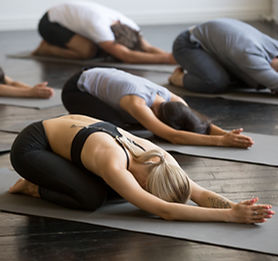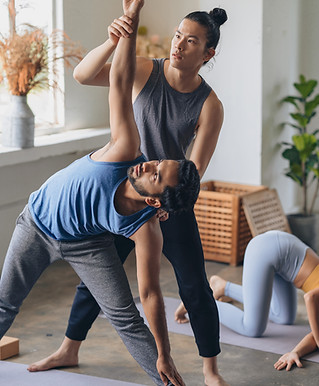
200-RYT

Yoga is a practice that teaches awareness
There are so many benefits of yoga, including stress relief, pain relief, increased flexibility and strength, improved circulation, better breathing, and calming of the parasympathetic nervous system. The practice of yoga is well demonstrated to reduce the physical effects of stress on the body and mind. The body responds to stress through a fight-or-flight response, which is a combination of the sympathetic nervous system and hormonal pathways activating and releasing cortisol, the stress hormone from the adrenal glands.
Cortisol is often used to measure the stress response. Committing to a regular yoga practice can help reduce the levels of cortisol. Most yoga classes end with savasana, a relaxation pose, which further reduces the experience of stress.
Yoga can ease pain especially in the lower back area, which is where most people tend to feel pain. Studies have shown that practicing yoga asanas (postures), meditation or a combination of the two, reduced pain for people with conditions such as cancer, multiple sclerosis, autoimmune diseases, hypertension, arthritis, and back and neck pain. Yoga can also improve flexibility, mobility, and can significantly increase range of motion. Over time, the ligaments, tendons, fascia, and muscles lengthen and increases elasticity.
Namaste!

Yoga Formats I Teach
I currently teach the following styles of Yoga:
· Ashtanga Vinyasa (primary series)
· Vinyasa Flow
· Yoga HIIT Fusion Flow
· Mommy and Me Yoga
· Yin Yoga
· Slow Burn Vinyasa
· Specialty group yoga for wedding parties, wellness events, and retreats

Yin Yoga
If you practice yoga regularly and do not regularly take a yin yoga class, you are missing out! Too much yang and not enough yin does not promote harmony and balance in our bodies. According to Chinese philosophy, Yin is negative and dark and Yang is positive and bright.
Yin is soft a soft energy flowing through our bodies. Whereas, Yang is the opposite and can be expressed by moving vigorously like in a Vinyasa or Ashtanga flow class. Yang energy is at its highest peak and we can feel drained when we release Yang energy. That’s why it is so crucial to balance these harmonies and quiet the mind and body with a yin practice.
Yin yoga is a slower paced style of yoga and a typical one-hour class will have about six postures. In a Yin Yoga practice, the body is held in yoga asanas for up to 5 to 8 minutes. These passive holds target the connective tissues and allows the fascia to become more flexible.
Usually, Yin postures will target tightness in and around the back, hips, pelvis, and legs. Give Yin yoga a try and bring some balance into your life.
Namaste

Vinyasa Yoga is a type of yoga that links breath with movement to attain balance in the mind and body. I am certified and trained to teach various styles of yoga which include Ashtanga, Roots (a beginner version of yoga), Vinyasa, Yin yoga, and Yoga for Cancer. My favorite type of yoga to teach is Vinyasa. I really enjoy teaching this style of yoga because I have complete control of how I want to sequence the movement and complexity of the asanas or yoga poses. I sequence my yoga flows to work every part of the body, so that my yoga students will be able to burn calories, increase their flexibility, and become stronger. I will often time focus on increasing strength or mobility in a certain part of the body like the back, gluteal muscles or the upper body.
A Vinyasa flow practice offers so many health benefits for the body that include increased flexibility, mental focus, cardiovascular conditioning, calorie-burn, muscle development, improved sleep, and a reduction in anxiety, stress and the stress hormone cortisol. During a one-hour Vinyasa practice, you can anticipate moving for approximately 45 minutes, with 5 minutes each dedicated to meditation, Savasana, and a quick warmup. You can easily burn up to 400 calories in a 45-minute flowing Vinyasa yoga class. I like to think of my Vinyasa yoga class as a moving meditation. Once I get my yoga students started with Sun Salutations, which includes lots of Chaturangas, Crescent Lunges, and Warrior poses, they forget all about their work and other issues that tend to clutter the mind.
Namaste!

Yoga and Ayurveda are like sister practices. Before I became a yoga teacher, I had already begun to incorporate Ayurvedic practices into my daily life by using spices like Turmeric, essential oils, herbs and a tongue scraper. The practice of Ayurveda comes from India and this practice has been around for more than 5,000 years.
Ayurveda is thought to be a practice of medicine that is built around avoiding imbalances around the elements of air, fire, water, and earth. However, in Ayurveda, imbalances are thought to start the progression of disease and inflammation in the mind and body. This system of medicine seeks to understand our deepest connections with the whole universe and the influences of the energies that make up the universe.
One of the most significant reasons I have embraced Ayurveda is this approach treats each individual, taking into account each person’s unique health condition. Imbalances in our body such as inflammation, pain, and stiffness cannot be treated the same for each person. Therefore, an individual health approach should be used to provide a solution that should not always include taking pills or injections. Rather, the goal of Ayurveda is to teach people how to stay fit and healthy through a deeper understanding of themselves and their own particular relationship with the environment around them. This system is also based on natural healing and strengthening the body through yoga, and the mind and body through meditation.
One of the best ways to start implementing Ayurveda practices is to know your Dosha. A dosha is the presence of one of three substances that are present in a person’s body. An imbalance of Vata, Pita, or Kapha can determine what needs to be balanced in the body to have optimal health. For example, Vata is the air element, Pitta represents the fire element, and Kapha is the water element. As you can see, you really cannot balance these earth elements in your body until you learn which of the dosha elements that represents your unique profile.
Check out this link to determine your Dosha, courtesy of Yoga Journal. Dosha Quiz
Here are some great Ayurveda rituals that you can begin to practice for optimal health.
· Meditate for at least 20 minutes a day
· Awake before the sun rises
· Practice yoga or stretching exercises at least twice a week
· Eat a healthy and nourishing breakfast and lunch according to your dosha type
· Have dinner no later than 7:00 p.m.
· Drink room temperature water and avoid cold drinks
· Try falling to sleep no later than 11:00 p.m.

I am passionate about practicing and teaching yoga for the mind, body, and soul as a tool for optimal health and wellness. I love how yoga connects you to the power of your breath. Whether you’re new to yoga or an advanced yogi, I can help you get to the stage you want to be.
I work with all levels from beginner to advance and somewhere in between. I teach yoga with a focus on alignment, breath, and posture. I create sequences to help strengthen your body and mind for optimal health. I also teach Mommy and Me yoga classes for moms or parents who want to experience yoga with their young toddlers. I can also work with you to create specific flows based on your needs for a home practice.
Contact me via e-mail to schedule a session at:








